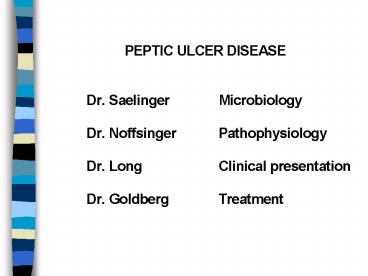HELICOBACTER PYLORI - PowerPoint PPT Presentation
1 / 14
Title:
HELICOBACTER PYLORI
Description:
A silver stain of H. pylori on gastric mucus-secreting epithelial cells (x1000) ... Vacuolating cytotoxin - induces vacuolation in epithelial cells that results in ... – PowerPoint PPT presentation
Number of Views:190
Avg rating:3.0/5.0
Title: HELICOBACTER PYLORI
1
(No Transcript)
2
(No Transcript)
3
A silver stain of H. pylori on gastric
mucus-secreting epithelial cells (x1000).
From Dr. Marshall's stomach biopsy taken 8 days
after he drank a culture of H. pylori (1985).
4
(No Transcript)
5
(No Transcript)
6
(No Transcript)
7
(No Transcript)
8
Nearly all H. pylori colonized persons have
gastric inflammation - but this - by itself is
asymptomatic. Symptoms are due to illness - such
as peptic ulceration or gastric
malignancy. Develop in lt10 individuals colonized
with H. pylori. Over 80 peptic ulcers related to
H. pylori colonization.
9
(No Transcript)
10
(No Transcript)
11
VIRULENCE FACTORS Initial
colonization facilitated by Acid inhibitory
protein - blocks acid secretion from parietal
cells during acute infection Urease -
neutralizes gastric acids due to ammonia
production. also stimulates monocytes and
neutrophil chemotaxis stimulates production of
inflammatory cytokines Heat shock protein -
enhances urease expression co-expressed with
urease on bacterial surface
12
Flagella - allows penetration into gastric mucous
layer Adhesins - mediate binding to host
cells Localized tissue damage mediated
by Mucinases and phospholipases - disrupt
gastric mucus Vacuolating cytotoxin - induces
vacuolation in epithelial cells that results in
epithelial cell damage
13
All these factors plus LPS stimulate
inflammatory response SOD and catalase - prevent
from phagocytosis and intracellular killing Plus
other poorly defined factors that stimulate IL-8
secretion by epithelial cells, that induce nitric
oxide synthase which mediates tissue injury, and
that induce programmed death of gastric
epithelial cells. Cag pathogenicity island -
includes genes that confer enhanced
pathogenicity, in part by inducing epithelial
cells to produce proinflammatory cytokines
14
(No Transcript)































